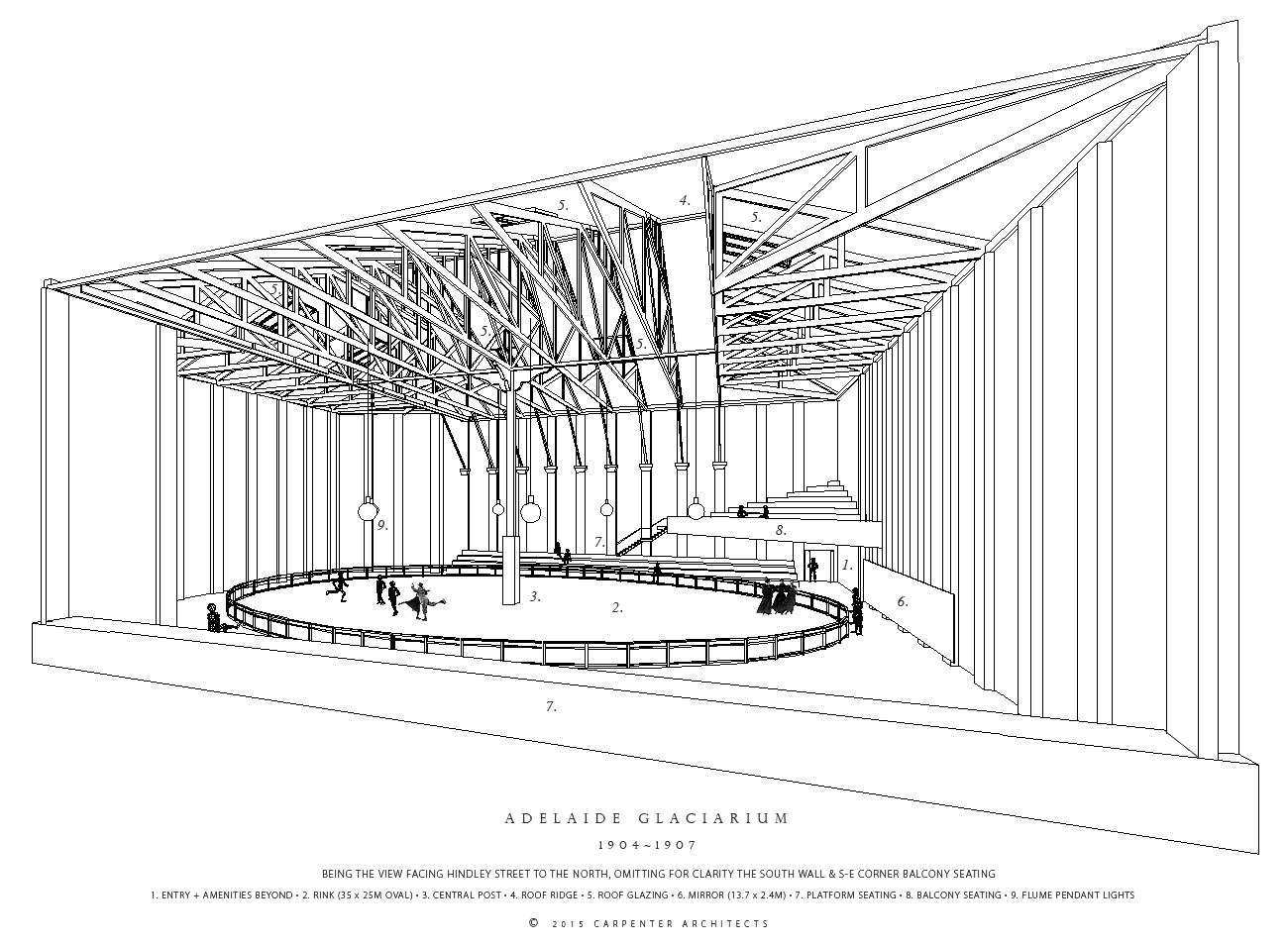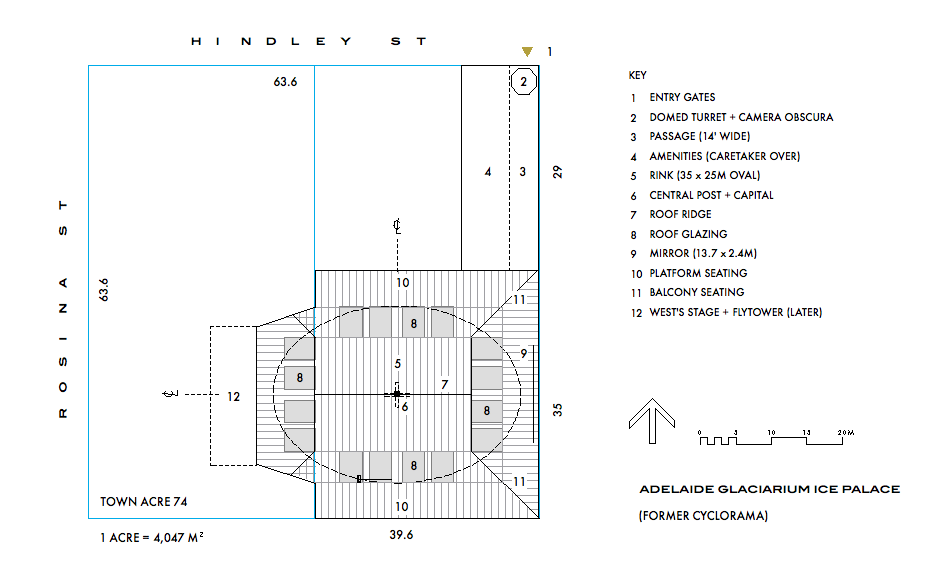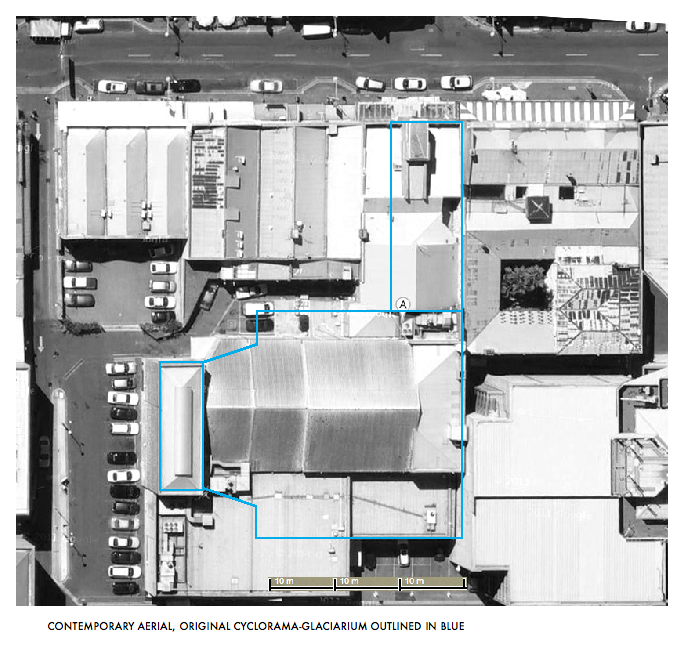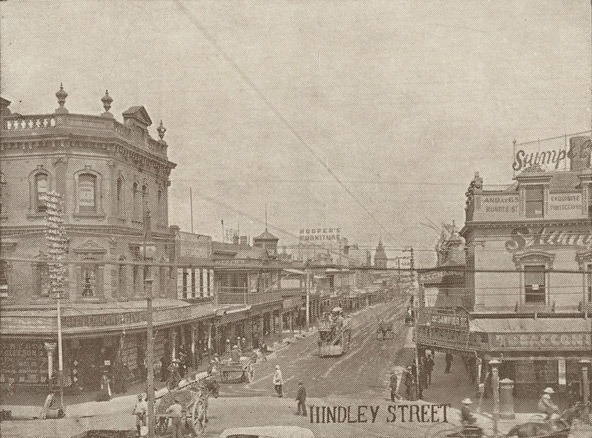CAREER SUMMARY
Birth
1894
Brighton Vic Australia
Death
11 Aug 1932
Sydney NSW Australia
Clubs
VIHA Melburnian, NSWIHA North Shore
Skating Championships
Ice Dance champion (with Mirey)
Goodall Cups
Vic: 1909, '10, '13 NSW: 1921, '23, '24, '25, '26
Accountant, wartime air mechanic
Notable home-grown speed skater
Founding Captain, NSWIHA North Shore
Founding vice-president, NSWIHA
State selector and administrator
BORN JANUARY 1894 AT BRIGHTON, a bayside suburb of Melbourne, Australia, he was the youngest son of Lucy Marsden and the founder of Australian ice sports, H Newman Reid. Like his brothers, Hal and Andy, Les was trained to ice skate by Poole, Caldwell, Langley and Brewer from about age 9. He first skated and played bandy in Adelaide and Melbourne where he attended St Peter's College Adelaide in 1904, and then Melbourne Grammar.
Reid played for Melburnian, one of the original four Australian ice hockey clubs, dominating the start-up years of the sport with his brother Hal and John Goodall. He joined the senior cadets at Caulfield for twelve months and served three years in the Army Reserve.
A member of the first Victorian Goodall Cup team at 15 in 1909 with brother Andy, he won 2 more Cups in 1910 and 1913. He was the first ice hockey player to represent two States, competing for New South Wales after the war, and winning 5 more Cups for a career total of 8. Les played cover-point (defence), with Jim Kendall at point (defence), and Pike at centre in the 1924 and 1925 interstate teams. Kendall, Reid and Pike shared the captaincy during the early 1920s, and Les captained the 1926 team with Pike as vice-captain, in the first Cup clash following Kendall's retirement as a player.
Slighter than his brother Andy, he stood 168 cm tall, and weighed just 62 kg. He had a fair complexion, blue eyes and fair hair, all of which conspired to produce the nickname, Snowy. He sported scars on his knee, thigh, back of neck and forehead at the age of 22, before he went to war.
A trade insurance inspector, accountant and wartime air mechanic, he became vice-president of Sydney's Glaciarium Ice Hockey Club when the sport resumed in 1920, with Jack Pike as president. They engaged American hockey star, Charles Uksila, and his sister Lena as trainers in Australia that season in the lead-up to the first Goodall Cup competition hockey since the outbreak of war in 1913.
In 1921, he was the founding Captain of North Shore Ice Hockey Club where his ability rivaled Jim Kendall, who was 12cm taller and almost 13 kg heavier. He represented New South Wales for many years, and he was unbeaten ice dancing champion of Australia with his sister Mirey, before ISU-affiliated national titles. He was a key selector of New South Wales State teams from the early 1920s, with Norm Joseph and Pike, at the start of the long period of New South Wales dominance of the Goodall Cup.
Reid was just 39 years-old when he died, the managing director of Galvanised Products Ltd in Glebe, a yachtsman and member of the Concord Golf Club. He left an imposing record as an administrator of New South Wales ice sports over a period of twelve years, from soon after the Great War, until his death on August 11th, 1932.
In that time, New South Wales won every Goodall Cup except one. His wartime flying squadron was reputedly the best Corps squadron in France, yet he had never collected nor even seen his victory medals. They signified a war in which a whole year of preparation, illness and delay had kept him at arm's length of the aerodromes protecting his brother Andy's battlefield, until months after Andy died.
Les picked up where Andy left off, finishing their vision of a national ice hockey competition with the same unrelenting clarity, the same kind of humilty, that defines good leaders. He gave ice sports in New South Wales the wings to fly, and that is exactly what they did. Within a decade and a half, the state produced some of the fastest and most successful speed skaters and amateur hockey players in the world.
Les was one of Australia's first home-grown speed skaters of note, one of its first outstanding hockey players, and one of the earliest and best, native-born male ice dancers in Australia after Albert Enders and Robert Jackson. He symbolised the very foundations of Australian ice sport in all its disciplines, and played the pivotal role in organising ice hockey and speed skating in NSW, and then nationally with John Goodall.
In 1949, seventeen years after his death, the St George Ice Hockey Club of Sydney presented the state Association with the Les 'Snowy' Reid Memorial Trophy for inter-team speed skating, when former St George captain and ice racer, Jim Brown, was still team manager and coach.
[1] Although, as some suggest, Leslie may have somehow been involved with the Sydney Glaciarium since it had opened its doors in July 1907, [2] he was only 13 years-old, and he had certainly lived in Melbourne until after the war. It is, however, likely that Leslie attended the opening celebrations that year. He probably performed there on July 27th, with his sister Mireylees, in Professor Caldwell's skating exhibitions.
[2] Leslie enlisted in the Australian Imperial Force at age 22, but he was discharged after three and a half months to join 2 Squadron, C Flight of the Australian Flying Corps on August 29th, 1916, as soon as it had first formed at Point Cook in Victoria. Confusingly, this unit was finally designated 3 Squadron AFC on January 20th, 1918 and it is referred to as that in military history. He was appointed on October 4th, 1916, at Laverton and he became an Acting Sergeant in the 38th Fortress Company, Australian Engineers. The Engineers were first founded in Victoria in 1860 and the former Drill Hall in Moore St, South Melbourne was their base. Leslie was soon promoted to Sergeant serving from the Sturt St Depot, virtually next to the Glaciarium ice rink and the workplace of his father and his brother, Hal.
HMAT Ulysees departed Melbourne on October 25th, 1916, arriving in Plymouth, England a few days after Christmas with Leslie's squadron. It was commanded by Major David V J Blake and based at RAF South Carlton in Lincolnshire. It's motto was 'Operta Aperta' or 'Secrets Revealed' and, at least as far as the British were concerned, it was reformed as 69 (Australian) Squadron, Royal Flying Corps. The air crews trained for eight months in Avro 504 and BE-2e aircraft, in co-operative roles with the artillery and army, before they were re-equipped for three flights of six British RE8 two-seat, biplane reconnaissance and bomber aircraft. These planes had experienced high casualty rates for most of the war. They were the first of the two seater bi-planes, with guns front and rear, and so they needed to be very carefully balanced. They were outclassed in speed and maneuverability by the German Scouts, and the Allied reconn squadrons had to soldier on with old, slow and antiquated British machinery. Leslie was promoted to First Class Air Mechanic in February, 1917.
These men and their machines set out on the first leg of their journey to France in August of 1917, without Leslie. He had been admitted to Hospital with influenza for three weeks, treated for six weeks and, for whatever reason, served as a storeman at the Engineering Depots at Lichfield, Bulford and Hurcott where he was also trained in aerial gunnery. He did not rejoin his squadron until early 1918 and, in the meantime, they were deployed at Savy aerodrome where they worked closely with two other RFC squadrons until they were confident enough to take on a sector of their own. In early November, they moved to Bailleul, in direct support of Australian Infantry there. Their sector covered the Messines area where Leslie's brother Andy had been killed a few months earlier. They fought grimly and extremely aggressively to maintain their patch of the sky. Their first victory was recorded on December 6th, and Leslie arrived in February to find them flying in a sector of the Somme Valley facing German planes commanded by the "Red Baron"; Manfred von Richthofen, the German air ace who had been credited with eighty confirmed victories. Richthofen was engaged in air battle with RE-8s from Leslie's squadron when he was shot down and killed behind Allied lines on April 21st, 1918, and the disposal of his remains became their responsibility. Blake initially reported that one of his RE8s shot down Richthofen, but he later formed the view that ground-based Australian machine-gunners had killed him. The 'Baron' was twenty-five years old.
Late in June 1918, Leslie's Squadron was involved in experiments in aerial supply methods for ground troops; in July it contributed to noise diversion operations related to the battle of Hamel; it assisted Allied movements in the battle of Amiens by dropping smoke bombs; and it continued its reconnaissance duties during the Allied advance to the Hindenburg Line. Its last offensive operations were on the day before the signing of the Armistice. The squadron disbanded in February, 1919 after providing a military air mail service from the end of the war. During its year of battles, Leslie's squadron suffered 23 fatal casualties and lost 11 aircraft over enemy lines. But it had shot down 51 enemy aircraft and flew over 10,000 operational hours of bombing, artillery spotting and reconnaissance missions, supporting ANZAC and other British Empire ground forces. It flew from ten different aerodromes, observed and reported on 735 artillery exchanges, dropped over 6,000 bombs, fired at least a half a million rounds against enemy targets, and exposed over 6,000 photographic plates covering some 1,200 square miles of enemy territory. During that time, 88 pilots and 78 reconnaisance observers were attached to the Squadron, of whom 11 pilots and 13 observers were killed in action, and another 12 pilots and 12 observers were wounded and hospitalised. [100] Leslie had served in England and France as one of a total of twenty-seven First Class Air Mechanics in the Australian squadron that first entered the Western Front, and left it with the greatest battle honours. The "Ghost RE8" was theirs; they were intimately involved in the Red Baron's last battle and the subsequent medical inquiries into his death; and they also flew "Sylvia", the RE8 that had flown more flights over German lines than any other Australian or British aircraft.
[3] Meanwhile, back in Melbourne, international liaisons were already afoot that would soon dramatically transform ice sports in both Melbourne and Sydney, elevating them to world standard (see Robert Jackson). However, Henry's elderly mother had died, one son had been killed, and the odds of the other returning home safely from the same Front line, worsened before they improved. Then, to top it off, the Glaciarium in Melbourne had been damaged by fire in 1917, the same year in which Andy was killed. Not surprisingly, the Reids had decided to move on. Henry and Lucy had been dividing their time between Melbourne and various Sydney hotels and guest houses, but they had settled at Cremorne Point on the North Shore of Sydney Harbour around June 1917. A Monster Benefit at the Sydney Glaciarium on June 21st, raised proceeds for the French-Australia League of Help, to assist war devasted areas in France, and Leslie's father now worked with the Kent Brewery of Tooth & Co. Its founder, Robert Tooth (1821-1893) had since died, but he had been a contemporary of Henry's father from Kent in England, where Henry was born. He was also an associate of Thomas Mort, who had established the New South Wales Fresh Food & Ice Co in 1875, with patents purchased from its Melbourne pioneer, James Harrison. This was the first commercial refrigeration company in Australia. Henry's business address was George St West from 1922, Sydney's most famous street, in which the Glaciarium was located at number 849. George Street begins near the Harbour Bridge, and extends to the southern end of the city, near Central Station and Ultimo, where it leads into Railway Square, and the former Sydney Cold Stores and Glaciarium. Samuel Barraclough, engineer of the Sydney Glaciarium, and the New South Wales Association's Doc Murphy, both worked nearby at Sydney Technical College, in Ultimo. Today, George Street continues from there as Broadway, where the Kent Brewery is still located, leading to the western suburbs as the Parramatta road.
[4] Leslie's sister, Mireylees, also moved to Sydney, probably with her parents, although their father had still kept an address at Collins Place in Melbourne, at least until 1918. The Reids may have planned to return when the damaged Melbourne rink was re-opened but, either way, it was not to be. P & O's RMS Kaiser-i-Hind departed Southampton, England for Melbourne on May 6th, 1919 with Leslie and the personnel of all four AFC squadrons onboard. They disembarked on June 16th, and Leslie was discharged six weeks later on July 31st. His father had tried to pre-arrange Sydney disembarkation, only to be told his sons or relatives would have 'to undertake the cost of their return when they were required to rejoin their respective units'. Leslie was now 23-years-old and he had spent most of his teens and adult life soldiering, including Cadets and Army Reserve. Hockey re-started in Melbourne that year, [1] and he may have played-out a season that was yet to be properly organised, but only his older brother Hal stayed on. And so it was, that all but one of the surviving founders and original builders of ice sports in Australia had congregated in Sydney when hockey resumed there in the winter of 1920.
[5] Since inception in 1907, both Glaciarium Ice Hockey Club (GIHC) and Glaciarium Figure Skating Club (GFSC) in Sydney had been controlled by Dunbar Poole, in the employ of the rink's management company, South Pole Ice Rink Limited. On April 30th, 1920, it was taken over by Sydney Cold Stores, on the condition that the old company continue the business until completion of the purchase. Like its predecessor, it was a publicly listed company; James Thonemann was a major investor, along with other Melbourne investors; and it was expected to return dividends to its shareholders. [126] On May 15th, The Argus in Melbourne reported, "The Melbourne secretary to Sydney Ice Skating Rink and Cold Storage Company Limited advises receipt of a telegram from the head office that the company is to be reconstructed..." [188] and went on to outline a new capital and share structure of £200,000 divided into 300,000 shares of £1 each. The number of shares were doubled and issued to the existing holders, providing them with two £1 shares for each one they presently held. At that time, the business administration of the Sydney rink was still carried out by a company secretary based in Melbourne. The Thonemanns were a wealthy Melbourne family of ASX security brokers and dealers, trading as Thonemann Robertson Thompson Pty Ltd. James' brother, Harold, held financial interests in at least five ice works and distilleries over the years, and James himself was a veteran of the first Australian ice hockey team of 1906; captain of the first ice hockey team to visit Sydney in August 1907; [2] and a financial associate of Henry Reid.
[6] In June 1921, when Interstate games resumed, the GIHC was replaced by the Sydney Ice Hockey Club with Poole as president. However, within a few months a benefit night had been organised for Poole; a documented club constitution had been adopted and, "a committee elected at the Annual General Meeting were responsible for the day to day organisation of Ice Hockey. There was no further mention of Poole as Patron or president. There was no permanent Chairman of the Committee ... one was elected at each meeting from the club delegates." [2] In 1922, communications commenced with the VIHA in Melbourne on the subject of rules. In 1923, the first National ice hockey association was formed from both States [2] and John Goodall, VIHA president and captain of Victoria, was appointed inaugural president.
The Melbourne founders had arrived in Sydney, and they were not on holiday. It was vice-president Leslie Reid who had proposed the GIHC name be changed to Sydney Ice Hockey Club, foreshadowing its transformation from Poole's autocracy, to corporate body; from city to State; and from State to National Association. [2] The Reid and Thonemann families of Melbourne stood a little behind him, overseeing their investment. Although the VIHA was set-up in Melbourne in 1908, comparatively little had been achieved for New South Wales or National ice sports during the thirteen years that Poole had been administrator. Suddenly, in quarter time, ice hockey was re-organised from scratch in Sydney; extended Statewide for the first time; then Nation-wide in collaboration with the VIHA. Poole had been politely but expertly sidelined, and a similar task still lay ahead of Leslie and Mireylees Reid in the skating disciplines. The story that unfolded there was quite different, but this had all been built for ice hockey in a few seasons, to the lasting credit of both States, from the trusted friendships and powerful alliances that had landed in Sydney with Leslie Reid. Little more than a decade on, ice hockey in New South Wales had been re-engineered and was poised on the brink of its first Golden Age.
[7] Leslie lived at the Reid family home, Locksley at Haverbrack Avenue in Malvern, until shortly after his return from the Great War in July 1919.
[8] After the early work with the Reids in Adelaide and Melbourne, Dunbar Poole pursued his figure skating ambitions overseas, limiting his Australian contribution exclusively to New South Wales. The writings of Sydney Tange [2] lionized him long after he had died, at the expense of the Reids. "The History of the Goodall Cup" [1] was put aside, and Poole was credited with founding ice hockey in Australia, instead of Leslie's father, the accepted wisdom until then. [1, 2] Reid's service records show he lived at the Reid family home in Melbourne when he enlisted in 1916; returned to Melbourne briefly after the war in 1919; then moved to Sydney to join the remains of his family. The youngest of Reid's three sons, he was from Victoria, the birthplace of Australian ice sports; a mechanic, a fixer, and still on a mission. Within a few short years, he had completely overhauled the administrative engine of ice hockey and speed skating in Sydney, which had been Poole's responsibility for well over a decade. He was ably assisted by Norm Joseph, another Victorian, a trusted family friend of the Reids in Melbourne, long before either had moved to Sydney. In fact, their family ties stretched back over a century to Edinburgh in Scotland. Melbourne-born Reg Boyden was also a founding member of North Shore IHC, and he probably worked in his father's Sydney accounting firm, Boyden Sons & Co. [257] Between them, they developed the constitution, rules, organisational structures, and protocols for the first ice sports association of New South Wales, on behalf of the membership. In fact, their mandate went farther still because Leslie Reid, Norm Joseph and Jim Pike were elected as local and State team selectors during the foundation years; July 1920, May 1921 and again in March 1922. Neither Poole nor Kendall held office as a selector. [2]
This new wave of organisers in Australia were well-connected on multiple fronts to innovations in American ice sports, and by 1919 Australian ice sports no longer took their lead from Britain. This was a conscious and well-informed choice, determined cooperatively by the new organisers in both Sydney and Melbourne, and reflecting a deep respect and desire for the professionalism emerging in North America. Since its foundation in 1907, the International Skating Union of America (ISUA) had claimed governance of all sports on ice in North America—figure skating, speed skating and hockey—in direct competition with the International Skating Union (ISU) founded fifteen years earlier. In 1914, it delegated the regulation of figure skating to both of the national governing bodies which were ultimately created for figure skating in the United States and Canada. It then relinquished control of hockey and morphed into the governing body for speed skating in America after 1927. In this way, America ended up with separate governing bodies for figure skating and speed skating. By comparison, the ISU (Europe) started out in 1892 as the international governing body for both figure skating and speed skating, and it remains that way still today. All of which serves to highlight how remarkable it was that ice hockey and speed skating in Australia, led by Leslie Reid and John Goodall, were officially combined under a unified national authority in 1923, and remained so until the early-1950s (see Racing Champions). Part of the reason for this was an association that ran much deeper than the prominent Reid and Goodall families, Melbourne Grammar and ice sports. In 1924 Les, his brother Hal and John Goodall floated a public company with a capital of £15,000. They were the first directors of Galvanised Products Ltd at Glebe in Sydney, manufacturers of sheet metal products. Leslie Reid was Managing Director until his death. [395]
[9] We will never know whether "the whole place rang with cheers and applause" as it did for Andy, but it appears not. Tange was no doubt a good man, and this is no slight on his notable contribution, nor on the National trophy which has perpetuated his name since 1969. But his reasoning was affected by sentimental allegiances. As a result, the historical record to which he had access was diminished, as were the quieter achievements of those who died young.
[10] Died on the upper North Shore at 74 Springdale Road, Killara, 14km north-west of the Sydney business district. His parents placed a notice in The Argus in Melbourne.
[11] He never married and he had lived near his sister Mireylees for most of his time in Sydney. Leslie Herbert Reid led New South Wales ice hockey out of the woods.
[12] OBITUARY. MR. L. H. REID. Mr Leslie Herbert Reid, who died at a private hospital on Thursday, aged 39 years, was born In Brighton, Victoria, and educated at Melbourne Grammar School. During the Great War he served for three years with No 3 Squadron of the Australian Flying Corps, and returned to this State in 1919. Up to the time of his death he was managing director of Galvanised Products, Ltd, Glebe. Mr Reid, who was unmarried, was a well known ice skater and ice-hockey player, having played for both Victoria and New South Wales between the years 1912 and 1926. He was also interested in yachting and golf, and was a member of the Concord Golf Club. The remains were privately Interred at South Head Cemetery on Saturday. The Rev. E. Shipley conducted the service at the graveside. [394]
[13] He was, without question, the founding president of the New South Wales Ice Hockey and Speed Skating Council; the first controlling authority of any ice sport in that State. Yet, in a sad twist of irony, Dunbar Poole was made the first Life Member of the New South Wales Ice Hockey Association, the year after Leslie Reid died.
[14] In 1949 when the Les 'Snowy' Reid Memorial Trophy was established, Harold Hoban had retired as president of the New South Wales ice hockey association three years earlier in 1946, and Brown was made an Honoured Life Member in 1951, the year the Brown Trophy for speed skating was discontinued (see Racing Champions). Poole had retired as manager of Sydney Glaciarium years earlier in 1937, but he returned in 1938 to open and manage Bendrodt's Ice Palais rink at Moore Park in Sydney. Late that year, in the aftermath of the Canadian Bears vs St George match, he was manager of the Ice Palais when his employer formed the break-away group that posed "the first threat to Australian controlling bodies" (see Tom Coulter). St George was one of the most successful New South Wales clubs in Australian hockey history, and this controversy took place seven months after Australia had finally affliated with the International Ice Hockey Federation (IIHF) on February 11th, 1938. Sydney rinks opened in March and closed in early-October during these years, [2] and so Australia's affiliation with the IIHF had occurred in the off-season, shortly after Poole had retired, and before he returned as manager of the newly opened Ice Palais. Poole retired again a few years later in 1941; permanently this time, when the Ice Palais was requisitioned for the war effort. He was 64 years-old.
[15] He rode a motor cycle in his youth, and with relish, because he was fined two pounds by Prahran Court for speeding in September, 1915.
[16] He may have traveled to Britain, Canada and the United States with the cadets in 1910. [375]
[17] Leslie's father was the administrator of his estate, and it was he who fourteen years later collected his medals, as he had earlier done for Andy.
Ross Carpenter, 'Reid, Leslie Herbert (1894-1932)', Legends of Australian Ice, Melbourne, Australia, http://icelegendsaustralia.com/legends-2/bio-reid-l.html, accessed online .







